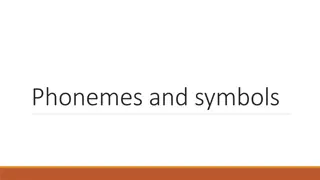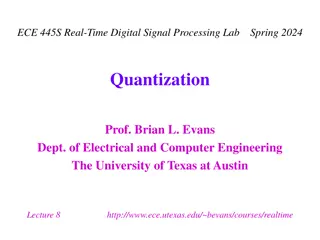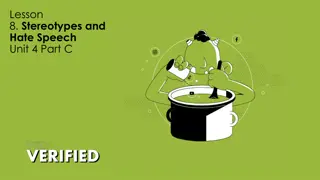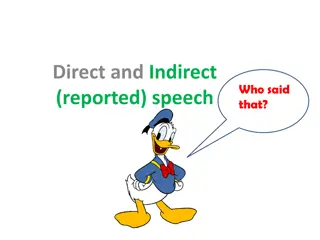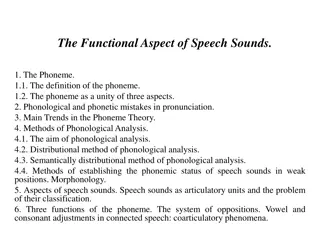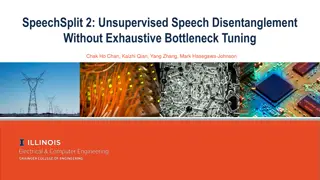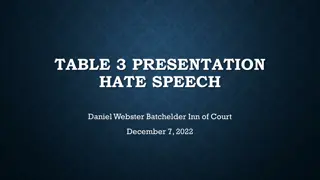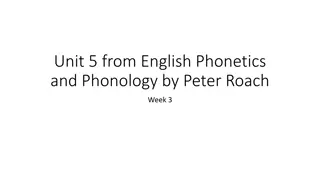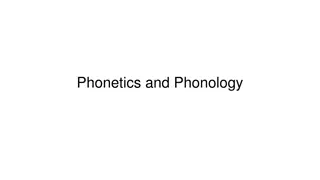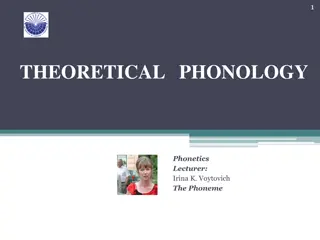Understanding Speech Signal Processing and Phonemes
Delve into the world of speech signal processing, exploring applications like speech storage, recognition, and synthesis. Discover how different languages utilize phonemes to convey meaning through various acoustic units. Uncover the intricacies of speech sampling and phoneme types, from vowels to consonants and semivowels.
Download Presentation

Please find below an Image/Link to download the presentation.
The content on the website is provided AS IS for your information and personal use only. It may not be sold, licensed, or shared on other websites without obtaining consent from the author. Download presentation by click this link. If you encounter any issues during the download, it is possible that the publisher has removed the file from their server.
E N D
Presentation Transcript
Speech signal processing Y(J)S DSP Slide 1
Application: Speech Speech is a wave traveling through space at any given point in space it is a signal in time The speech values are pressure differences (or molecule velocities) There are many reasons to process speech, for example speech storage / communications speech compression (coding) speed changing, lip sync text to speech (speech synthesis) speech to text (speech recognition) translating telephone speech control (commands) speaker recognition (forensic, access control, spotting, ) language recognition, speech polygraph, voice fonts Y(J)S DSP Slide 2
Speech in the time domain D IGI T A L S I GNA L PROCESSING Why don t we see the letters? Y(J)S DSP Slide 3
Speech in the frequency domain Why don t we see the letters? Y(J)S DSP Slide 4
Phonemes A phoneme is defined to be the smallest acoustic unit that can change meaning Different languages have different phoneme sets and their speakers hear sounds differently in Hebrew there is no TH phoneme, so speakers substitute Z in Arabic there is no P phoneme, so speakers substitute B in English there is no phoneme, so speakers substitute K in Japanese there is a single phoneme somewhere between English R and L Some languages have many phonemes Danish has 25 different vowels Taa has over 150 consonants Xhosa has 3 different click sounds Some have very few Piraha has 3 vowels and 8 consonants Hawaiian has only 3 consonants Y(J)S DSP Slide 5
Some phoneme types Vowels front (heed, hid, head, hat) mid (hot, heard, hut, thought) back (boot, book, boat) dipthongs (buy, boy, down, date) Consonants nasals (murmurs) (n, m, ng) stops (plosives) voiced (b,d,g) unvoiced (p, t, k) fricatives voiced (v, that, z, zh) unvoiced (f, think, s, sh) affricatives (j, ch) whispers (h, what) gutturals ( , ) clicks etc. etc. etc. Semivowels liquids (w, l) glides (r, y) Y(J)S DSP Slide 6
Speech sampling Telephony speech is from 200 to 4000 Hz this is not enough for all sounds we can hear not really even enough for speech (e.g., S - F) high quality audio is from 20 Hz to over 20 kHz By the sampling theorem we need 8000 samples per second high quality audio typically sampled at 44.1 / 44 / 48 kHz If we sample at 8 bits per sample we perceive significant quantization noise (see next slide) So, let s assume we should sample at 16 bits per sample actually 13-14 bits is enough So we need 8000 samples/sec * 16 bits/sample = 128 kbits/sec to faithfully capture telephony quality speech Information theory tells us that speech actually only carries a few bits per second So we should be able to improve this but we need to learn more about the speech signal! Y(J)S DSP Slide 7
Whats quantization noise? When we quantize a signal value sn to the closest integer (or rational) we add an error value xn = sn + qn Assuming the qn samples are uncorrelated the quantization noise is white noise We hear white noise as a hiss qn [- 2-n, 2-n] (or [- 2-n, 2-n] if we assume the signal is in [-1 , 1]) So the more bits we use the better the Signal to Noise Ratio Each additional bit reduces the SNR by a factor of 2 (3 dB) Y(J)S DSP Slide 8
Speech biology To understand the speech signal we need to learn some biological signal processing There are two separate systems of interest speech generation system lungs windpipe vocal folds (cords) vocal tract (mouth cavity, tongue, teeth, lips, uvula) Broca s area (in left hemisphere) speech recognition system outer ear ear drum and hammer cochlea, organ of Corti (cilia) auditory nerve medial geniculate nucleus (in thalamus) auditory cortex and Wernicke s area (in superior temporal gyrus) These two systems are not well matched Y(J)S DSP Slide 9
Speech Production Organs Brain Hard Palate Nasal cavity Velum Teeth Lips Uvula Mouth cavity Tongue Pharynx Esophagus Larynx Trachea Lungs Y(J)S DSP Slide 36
Speech Production Air from lungs is exhaled into trachea (windpipe) Vocal cords (folds) in larynx can produce periodic pulses of air by opening and closing (glottis) Throat (pharynx), mouth, tongue and nasal cavity modify air flow Teeth and lips can introduce turbulence Basic function filter an excitation signal (we will see that the filter can be modeled as an AR filter) Y(J)S DSP Slide 37
Hearing Organs Y(J)S DSP Slide 38
Hearing Organs Sound is air pressure changing over time (and propagating through space) Sound enters the external ears which collect as much sound energy as possible (like a satellite dish) differentiate between right/left and front/back even differentiate between up and down Sound waves impinge on outer ear enter auditory canal Amplified waves cause eardrum to vibrate Eardrum separates outer ear from middle ear The Eustachian tube equalizes air pressure of middle ear Ossicles (hammer, anvil, stirrup) amplify vibrations Oval window separates middle ear from inner ear Stirrup excites oval window which excites liquid in the cochlea The cochlea is curled up like a snail The basilar membrane runs along middle of cochlea The organ of Corti transduces vibrations to electric pulses Pulses are carried by the auditory nerve to the brain Y(J)S DSP Slide 39
Cochlea Cochlea has 2 1/2 to 3 turns (for miniaturization) were it straightened out it would be 3 cm in length The basilar membrane runs down the center of the cochlea as does the organ of Corti 15,000 cilia (hairs) contact the vibrating basilar membrane and when it vibrates they release neurotransmitters stimulating 30,000 auditory neurons Cochlea is wide (1/2 cm) near oval window and tapers towards apex and is stiff near oval window and flexible near apex hence high frequencies cause vibrations near the oval window while low frequencies cause section near apex to vibrate Basic function Fourier Transform (by overlapping bank of bandpass filters) Y(J)S DSP Slide 40
Voiced vs. Unvoiced Speech We saw that air from the lungs passes through the vocal cords When open the air passes through unimpeded When laryngeal muscles close them glottal flow is in bursts When glottal flow is periodic we have voiced speech basic interval/frequency called the pitch (f0) pitch frequency is between 50 and 400 Hz You can feel the vocal cord vibration by placing your fingers on your larynx A laryngeal microphone directly perceives the sound at this point even opening you mouth very wide doesn t work very well Vowels are always voiced (unless whispered) Consonants come in voiced/unvoiced pairs Y(J)S DSP Slide 15
Exercise Which are voiced and which are unvoiced ? B, D, F, G, J, K, P, S, T, V, W, Z, Ch, Sh, Th (the), Th (theater), Wh, Zh Which unvoiced phoneme matches the voiced one? B D G V J Th (the) W Z Zh Y(J)S DSP Slide 16
Excitation spectra Voiced speech is periodic and so has line spectrum Pulse train is not sinusoidal due to short pulses of air and is rich in harmonics (amplitude decreases about 12 dB per octave) f pitch Unvoiced speech is not periodic Common assumption : white noise (turbulent air) f Y(J)S DSP Slide 17
Effect of vocal tract So what is the difference between all the (un)voiced sounds? The sound exiting the larynx enters the mouth cavity and is filtered Mouth and nasal cavities have resonances (poles) similar to blowing air over a bottle Thus the sound exiting the mouth is periodic (due to periodic excitation) but with some harmonics strong and some weak Resonant frequencies depend on geometry in particular mouth opening, tongue position, lip position Y(J)S DSP Slide 18
Effect of vocal tract - cont. Sound energy at resonant frequencies is amplified Frequencies of peak amplification are called formants frequency response F1 F2 F3 F4 frequency unvoiced speech voiced speech F0 Y(J)S DSP Slide 19
Cylinder model(s) Rough model of throat and mouth cavity (without naval pathway) Voice Excitation With nasal pathway destructive interference Voice Excitation
Formant frequencies Peterson - Barney data (note the vowel triangle ) f2 AE = hat AH = hut AO = ought EH = head ER = hurt IH = hit IY = heat UH = hood UW = who f1 Y(J)S DSP Slide 21
Sonograms Which sounds are voiced? Where is the pitch? Where are the formants? Y(J)S DSP Slide 22
Simple model for speech generation Pulse Generator U/V switch G synthesis filter s White Noise Generator Y(J)S DSP Slide 23
LPC Model This model was invented by Bishnu Atal (Bell Labs) in 1960s pulse generator produces a harmonic rich periodic impulse train white noise generator produces a random signal U/V switch chooses between voiced and unvoiced excitation varying gain allows to speak loudly or softly (typically placed before the filter) LPC filter amplifies formant frequencies (no zeros but peaks - all-pole or AR IIR filter) Note: standard LPC doesn t work well for nasals destructive interference creates zeros in the frequency response output resembles true speech to within modeling error Y(J)S DSP Slide 24
Can LPC compress speech? Let s estimate the number of bits/second required to capture speech (for transmission or storage) using the LPC model we need to model several times per phoneme no-one can produce more than a few phonemes per second 20-100 frames per second is reasonable, let s assume 25 we need to specify the pitch (between 50 and 400) in Hz 1 byte is more than enough (no-one hears the difference of 1 Hz!) we need 1 bit for the U/V switch but don t have to waste a bit since we can encode as pitch with zero frequency we need to capture the gain 1 byte is enough (our ear is not that sensitive to small gain changes) the AR filter has 4 formants so we need 8 values (4 frequencies and 4 amplitudes or 8 poles) and once again will assume 1 byte for each Altogether we need 25 * (10 bytes * 8 bits/byte) = 2000 bits/sec much better than 128,000 bits/sec Y(J)S DSP Slide 25
LPC ? Why is this model called Linear Predictive Coding ? The synthesis filter performs sn = mbm sn-m which predicts the next signal sample based on a linear combination of previous samples Most of the time we can forget about the glottal excitation but this introduces an error en So we define sn = en+ mbm sn-m This defines a classic AR model, solvable using Yule-Walker Y(J)S DSP Slide 26
How do we do it? Given a frame of speech samples (x0, x1, x2, ... xN-1) how do we find the LPC parameters? the gain is easy to find it requires calculating the energy U/V can be found by observing the spectrum if lines then voiced, if continuous then unvoiced the pitch can be determined by lowest spectral peak or frequency difference between peaks autocorrelation since the input to the AR filter can now be created and the output is the speech samples we now have an AR filter system identification problem so the filter can be found by solving the Yule-Walker equations Y(J)S DSP Slide 27
Does it work? An early commercial use of LPC was the Texas Instruments Speak & Spell chip which used LPC-10 (10 AR coefficients) An early software implementation was Klattalk Pure LPC speech sounds robotic (Steven Hawking speech) because we need to add prosodic modeling we need to post process to clean up estimation errors e.g., pitch doubling we need to add frame-to-frame processing e.g., pitch needs to change smoothly but most importantly pitch pulses are not deltas or on-off rectangles they have waveforms that influence the sound Y(J)S DSP Slide 28
Better speech compression Compressing telephony quality speech was once a tremendously important problem The International Telecommunications Union set goals to reduce speech transmission rates by factors of 2 We can thus compare: 128 kbit/sec linearly quantized speech 64 kbit/sec Pulse Code Modulation (logarithmic quantization) 32 kbit/sec Adaptive Delta PCM 16 kbit/sec was never standardized 8 kbit/sec Code Excited LPC But we now need to understand some psychophysics Y(J)S DSP Slide 29
Psychophysics Psychophysics is the subject that combines psychology and physics Its fundamental question is the connection between external physical values (light, sound, etc.) internal psychological perception Ernst Weber was one of the first to investigate of the senses In a typical experiment a subject is asked in which hand there are more coins 1 coin in 1 hand and 2 coins in the other is easily noticeable 10 coins in 1 hand and 11 coins in the other is just noticeable 41 coins in 1 hand and 42 in the other is not noticeable But how could this be? Can one notice the difference of 1 coin or not? Y(J)S DSP Slide 30
Weber Weber defined the concept of the Just Noticeable Difference (JND) the minimal change produces a noticeable difference Weber s important discovery was that JND varied with signal strength In fact, Weber found the sensitivity of a subject to X is in direct proportion to the X itself that is one notices adding a specific percentage not an absolute value I = k I Thus the number of noticeable additional coins is proportional to the number of coins and the same is true for saltiness of salty water length of lines strength of sound Y(J)S DSP Slide 31
Fechners law Gustav Theodor Fechner was a student of Weber While viewing the sun in order to discover JNDs he was blinded He later regained his sight and took this as a sign that he would solve the psychophysical problem Simplest assumption: JND is single internal unit Weber s law says we perceive external values multiplicatively Fechner concluded that internal unit is the log of the external one: Y = A log I + B People celebrate the day he discovered this as Fechner Day (October 22 1850) Y(J)S DSP Slide 32
Dynamic range Logarithms are compressive Fechner s law explains the fantastic ranges of our senses Sight (retinal excitation) minimum: single photon maximum (harm threshold): direct sunlight ratio: 1015 Hearing (eardrum movement) minimum: < 1 Angstrom 10-10 meters maximum (harm threshold): >1 mm (behind a jet plane) ratio: 108 Alexander Graham Bel defined to be log10 of power ratio A decibel (dB) one tenth of a Bel d(dB) = 10 log10 P1 / P2 Y(J)S DSP Slide 33
Fechners law for sound amplitudes According to Fechner s law, we are more sensitive at lower amplitudes We perceive small differences when the sound is weak but only perceive large differences for strong sounds Companding is the compensation for the logarithmic nature of speech perception We need to adapt the logarithm function to handle positive/negative signal values If we could sample non-evenly then this can be exploited for speech compression Y(J)S DSP Slide 34
Fechners law for sound frequencies octaves, well tempered scale 12 2 Critical bands Frequency warping f Melody 1 KHz = 1000, JND afterwards M ~ 1000 log2 ( 1 + fKHz ) Barkhausen can be simultaneously heard B ~ 25 + 75 ( 1 + 1.4 f2KHz )0.69 excite different basilar membrane regions Y(J)S DSP Slide 35
2 more psychological laws Respond to changes Our senses respond to changes not to constant values Masking Strong tones block weaker ones at nearby frequencies f Y(J)S DSP Slide 36
PCM 8 bit linear sampling (256 levels) is noticeably noisy But due to prevalence of low amplitudes in generated speech logarithmic response of ear we can use 8-bit logarithmicsampling ( with sgn(s) * log(|s|) ) G.711 gives 2 different logarithmic approximations -law North America = 255 A-law Rest Of World = 87.56 Although very different looking they are nearly identical G.711 standard further approximates these expressions by 16 staircase straight-line segments (8 negative and 8 positive) Note that -law has horizontal segment through the origin (plus and minus zero) while A-law has a vertical segment Y(J)S DSP Slide 37
Logarithmic sampling Y(J)S DSP Slide 38
DPCM Due to low-pass character of speech excitation differences are usually much smaller than signal values and hence require fewer bits to quantize This would not be the case for white noise! Simplest Delta-PCM (DPCM) : quantize first difference signal s Delta-PCM : it is even better to quantize the difference between the signal and its prediction sn = p ( sn-1 , sn-2, , sn-N ) = ipi sn i Since we predict using linear combination this is a simple type of linear prediction Delta-modulation (DM) : use only the sign of difference (1bit DPCM) Sigma-delta (1bit) sampling : oversample, DM, trade-off rate for bits Y(J)S DSP Slide 39
Deltas are usually small The first difference requires fewer bits if 4 bits is enough then we need 32 kb/s Y(J)S DSP Slide 40
DPCM with prediction If the linear prediction works well, then the prediction error n = sn - sn will be lower in energy and whiter than snitself ! Only the error is needed for reconstruction, since the predictable portion can be predicted sn = sn + n! n sn sn - prediction filter prediction filter sn sn Y(J)S DSP Slide 41
Open loop prediction The encoder (linear predictor) is present in the decoder but there runs as feedback The decoder s predictions are accurate with the precise error n and as the error accumulates the signals diverge! but itgets the quantized error n sn n sn IQ Q - PF PF Y(J)S DSP Slide 42
Side information There are two ways to solve the error accumulation problem ... The first way is to send the prediction coefficients from the encoder to the decoder and not to let the decoder derive them The coefficients thus sent are called side-information Using side-information means higher bit-rate (since both n and the coefficients must be sent) The second way does not require increasing bit rate Y(J)S DSP Slide 43
Closed loop prediction To ensure that the encoder and decoder stay in-sync we put the entire decoder including quantization and inverse quantization into the encoder Thus the encoder s predictions are identical to the decoder s and no model difference accumulates n n sn sn Q IQ - IQ PF PF Y(J)S DSP Slide 44
Two more forms of error For DM there is another source of error (that depends on step size) much too large too small too large Y(J)S DSP Slide 45
Adaptive DPCM Speech signals are very nonstationary We need to adapt the step size to match signal behavior increase when signal changes rapidly decrease when signal is relatively constant Simplest method (for DM only): if present bit is the same as previous multiply by K (K=1.5) if present bit is different, divide by K constrain to a predefined range More general method : collect N samples in buffer (N = 128 512) compute standard deviation in buffer set to a fraction of standard deviation send to decoder as side-information or use backward adaptation (closed-loop computation) Y(J)S DSP Slide 46
G.726 G.726 (standard for international telephony) has adaptive predictor adaptive quantizer and inverse quantizer adaptation speed control tone and transition detector mechanism to prevent loss from tandeming computational complexity relatively high (10 MIPS) 32 kbps toll quality 24 and 16 Kbps modes defined, but not toll quality G.727 same rates but embedded for packet networks ADPCM only exploited general low-pass characteristic of speech What is the next step? Y(J)S DSP Slide 47
AVQSBC A good quality 16 kb/s speech encoder is obtained by exploiting Fechner s law for sound frequencies The idea is to use Sub-Band Coding We divide the signal in the frequency domain using perfect-reconstruction band-pass filters The frequency widths are small at low frequencies but large at high frequencies 0 Hz 4000 Hz Each subband is separate quantized using Vector Quantization This technique was never standardized for speech but SBC was standardized for music as MP3 audio Y(J)S DSP Slide 48
LPC10 For military-quality voice 180 sample frame (44.4 frames per second) are encoded into 54 bits as follows: Pitch + U/V (found using AMDF) 7 bits Gain 5 bits 10 reflection coefficients first two coefficients converted to log area ratios L1, L2, a3, a4 5 bits each a5, a6, a7, a8 4 bits each a9 3 bits a10 2 bits 41 bits 1 sync bit 1 bit 54 bits 44.44 times per second results in 2400 bps By using VQ one could reduce bit rate to under 1 Kbps! LPC-10 speech is intelligible, but synthetic sounding and much of the speaker identity is lost ! Y(J)S DSP Slide 49
CELP The true sn is obtained by adding back the residual error signal sn= sn + n So if we send n as side-information we can recover sn n is smaller than sn so may require fewer bits ! but n is whiter than sn so may require many bits! Can we compress the residual? Note that the residual error is actually the LPC filter s excitation The idea behind Code Excited Linear Prediction is to encode possible excitations in a codebook of waveforms and to send the index of the best codeword Y(J)S DSP Slide 50


